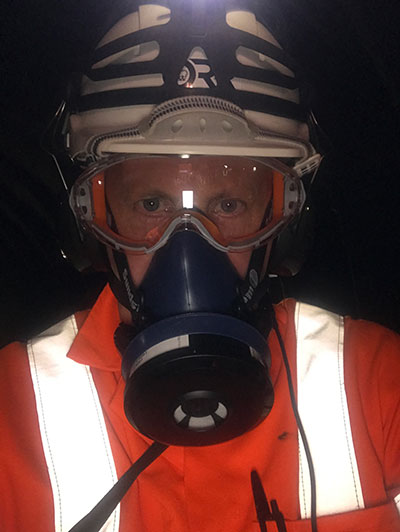The Office of Rail and Road (ORR) is responsible for ensuring that the mainline railway and London Underground operate networks that are safe for passengers and workers, and that is why around 100 ORR Safety Inspectors routinely visit worksites to monitor how projects are being run.
It is important that ORR Inspectors lead by example – and that means putting on full Personal Protective Equipment (PPE) before setting foot on site.
Commuters know that it can be hot on London Underground’s network, especially in stations and tunnels. Well, it’s even hotter at night when the trains aren’t running and pushing air through to cool things down a bit, and if you add in the effects of heavy safety boots, goggles, gloves, hard hats, ear defenders and thick trousers and jackets in a lurid bright orange, it can get really sticky down there.
Respiratory Protective Equipment (RPE) – a modern version of a WW2 gas mask – makes things even hotter, but it is essential when you’re working around silica dust which, after long-term exposure, can cause serious breathing difficulties and can even lead to death.
 Of course you can’t just put on RPE - you have to be ‘Face Fit Tested’. First you have a fitting for size and shape, then you are put in a sealed room and hooked up to special machinery and made to perform a series of tasks, including reading a poem, as the seal around the mask has to remain in place if people are talking while they are at work.
Of course you can’t just put on RPE - you have to be ‘Face Fit Tested’. First you have a fitting for size and shape, then you are put in a sealed room and hooked up to special machinery and made to perform a series of tasks, including reading a poem, as the seal around the mask has to remain in place if people are talking while they are at work.
Fully kitted out, we went down into a single bore tunnel to see track maintenance work being carried out near Barons Court Station on the Piccadilly Line. Work on the Underground mainly has to be carried out in five-hour periods when the trains aren’t running, so it was around 2am when we arrived on site.
We observed closely while workers broke up concrete so they could prise out the sleepers that hold the rails in place and replace them with a new type of fitting that holds the rail in place and needs to be cemented in. Water was sprayed over the area to dampen down the silica dust whilst it is broken out, but with the noise and heat, it was a very uncomfortable environment to work in.
The work is done at pace against the clock, but ORR Inspectors are there to see that workers’ health and safety is not compromised by the speed and, of course, that the work done meets rigorous safety standards.
Once the inspection is complete, ORR Inspectors hold a meeting with London Underground on what they have seen and advise on any changes to working practices that should be made.
Then, with enormous relief, it’s off with the PPE and on to the next site.


